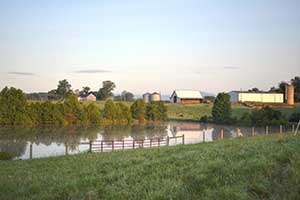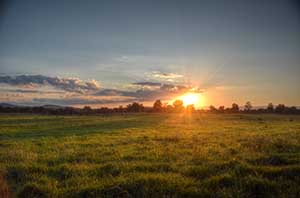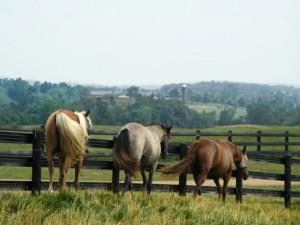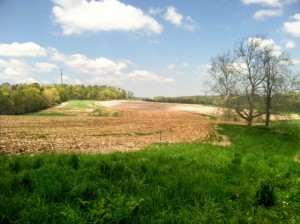Benefits of Buying a Farm in Virginia
 We will admit that we are a little biased. Some of us are more than partial to the farms in Madison County, where the heavens are spangled by luminous pink and copper-colored sunsets. But our proclivity toward the mountains aside, buying a home in the country is a great idea for several reasons. There are definitely urban amenities that a country home in central Virginia or a rural estate elsewhere in the Greater Charlottesville area can’t provide, but there are several benefits–financial and otherwise–to buying land in the country, and we’d love a chance to share some of these with you.
We will admit that we are a little biased. Some of us are more than partial to the farms in Madison County, where the heavens are spangled by luminous pink and copper-colored sunsets. But our proclivity toward the mountains aside, buying a home in the country is a great idea for several reasons. There are definitely urban amenities that a country home in central Virginia or a rural estate elsewhere in the Greater Charlottesville area can’t provide, but there are several benefits–financial and otherwise–to buying land in the country, and we’d love a chance to share some of these with you.
As far as the perks of country real estate go, price is one of the most readily apparent. We’re not even talking about crossing state lines here, because obviously you’d pay far less for 100 acres in Albemarle County than you would in New York City (if they even have 100 to spare up there). But these price discrepancies are observable even within property in the Greater Charlottesville area. According to recent data published by the Charlottesville Association of Realtors, land in Nelson County, Greene County, and Louisa is much more economical than homes in Charlottesville or land in Albemarle County. (Keep in mind that some of the land in Albemarle County is divided up into subdivisions, essentially suburbs of Charlottesville). The median price for a home in Albemarle County was $322,000. The median price for a home in Charlottesville was $271,000. The median price for a home in Nelson County was $179,000. The median price for a home in Greene County was $219,000, and the median price for a home in Louisa was $170,000 (all figures reflect data from the second quarter of 2015, with exception of the Louisa figures, which reflect data from the second quarter of 2014). By buying a country home in central Virginia, you pay less for more.
You literally save more by buying rural, but you also have the opportunity to generate revenue from your land. Within a few years of buying a plot of land in central Virginia, you can generate some healthy cash flow, and you can do it on your own terms. You get what you put into the land…so if you wanted to start a small organic farm with help from your friends or family, you could. If you wanted to build stables for a horse farm, you could do it. There are also opportunities to make a real career out of it, at your own pace. The land in central Virginia is good for so many things: breweries and hop farms, vineyards, orchards, livestock pasture…there really are endless possibilities. And with a decent-sized bit of farmland, you can explore them all.
 The competition is scant and sparse here in the country. Depending on what you want to do with the land, that may be a good or bad thing. Technically, the Greater Charlottesville area is a buyer’s market (for now at least), and nowhere is that more pronounced than out in the country. The median number of days-on-market for those country homes in Nelson County is 261, up 80 days from last year, and the sales price to list price ratio is 87.2%. However, Greene County’s median DOM dropped from 136 to 44, and Louisa showed similar improvement, meaning you may want to make your move in this area sooner rather than later. With this information in mind, if you’re looking to make a quick flip, rural properties aren’t for you. But for a community that wants to put down roots, you can’t beat it. The rural housing market is also much easier to predict.
The competition is scant and sparse here in the country. Depending on what you want to do with the land, that may be a good or bad thing. Technically, the Greater Charlottesville area is a buyer’s market (for now at least), and nowhere is that more pronounced than out in the country. The median number of days-on-market for those country homes in Nelson County is 261, up 80 days from last year, and the sales price to list price ratio is 87.2%. However, Greene County’s median DOM dropped from 136 to 44, and Louisa showed similar improvement, meaning you may want to make your move in this area sooner rather than later. With this information in mind, if you’re looking to make a quick flip, rural properties aren’t for you. But for a community that wants to put down roots, you can’t beat it. The rural housing market is also much easier to predict.
We’re certainly aware of the amenities that big cities offer. These tend to be characteristics geared toward younger people (as we know, recent college grads are flocking to big cities en masse). But these same things are reasons why living in the country is great. There’s typically less regulation in the country, giving you more autonomy. Zoning laws, for example are much more lenient if you own rural property, and there are less restrictions on what you can and can’t do. Also you can’t put a price on space (well I guess technically, that’s what real estate is)…but the feeling of waking up and seeing only familiar faces in every direction can be very powerful. Not until one experiences the hustle and bustle, the grit and grime of the city, can one truly appreciate what it means to be alone. Your stars and sunsets will be your own. You’re also looking at better tax rates and less crime by living in a rural area, due in part to the strong sense of trust and community connection that occurs here.
And really, it’s just a better lifestyle. There’s room to run around and enjoy the outdoors…hiking, fishing, hunting and swimming are so accessible that you’ll get bored of the activities. The air is crisp and fresh, the views are breathtaking, and the property values are low. What’s not to love? Call us today to find out more about the Farms in Virginia for Sale.
 When we think of horse farms in central Virginia, it’s probably easy to imagine an endless green sprawl with rolling hills, clear blue skies, and horses galloping unrestrained against the rugged landscape. We’re probably less likely to think of horses sitting around in stalls with nothing to do. But horse farmers know the reality; horses, like people are susceptible to obesity given certain conditions. Certain breeds of livestock are considered “easy keepers,” because in conditions that cause most of the herd to lose weight, they are adept at maintaining or even gaining weight. So most of the time it’s better and more desirable than a “hard keeper.” Ponies, as well as most mules and donkeys fit this description, as do many of the smaller, more durable species of horse like the Mustang and the Arabian. Easy keepers are desirable because it’s easy to keep them well-fed, but maintaining nutritional and dietary needs can be difficult.
When we think of horse farms in central Virginia, it’s probably easy to imagine an endless green sprawl with rolling hills, clear blue skies, and horses galloping unrestrained against the rugged landscape. We’re probably less likely to think of horses sitting around in stalls with nothing to do. But horse farmers know the reality; horses, like people are susceptible to obesity given certain conditions. Certain breeds of livestock are considered “easy keepers,” because in conditions that cause most of the herd to lose weight, they are adept at maintaining or even gaining weight. So most of the time it’s better and more desirable than a “hard keeper.” Ponies, as well as most mules and donkeys fit this description, as do many of the smaller, more durable species of horse like the Mustang and the Arabian. Easy keepers are desirable because it’s easy to keep them well-fed, but maintaining nutritional and dietary needs can be difficult. Chances are if you’re reading this, you are contemplating or have already purchased a beautiful piece of land or farm. A Virginia farm around Charlottesville and/or the Piedmont region is likely a resplendent piece of property, but it may require a little work before you can harness its full potential. Are you currently in possession of land that is, in its current state unsuitable for the construction of domiciles, rearing of livestock, cultivation of vineyards or any of the other various sundry things for which land in Virginia can be utilized? If you have found yourself deliberating the best way to clear your land, look no further than this guide! Here we give you a surface look at several different land clearing methods.
Chances are if you’re reading this, you are contemplating or have already purchased a beautiful piece of land or farm. A Virginia farm around Charlottesville and/or the Piedmont region is likely a resplendent piece of property, but it may require a little work before you can harness its full potential. Are you currently in possession of land that is, in its current state unsuitable for the construction of domiciles, rearing of livestock, cultivation of vineyards or any of the other various sundry things for which land in Virginia can be utilized? If you have found yourself deliberating the best way to clear your land, look no further than this guide! Here we give you a surface look at several different land clearing methods.